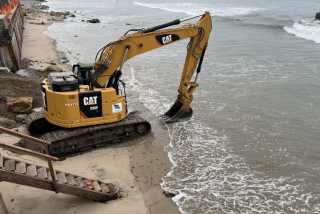Rejects Trade-Off of Increased Access for Seawall : Colony Refuses to Open Beach to Public
- Share via
Residents of Malibu Colony--the oceanfront enclave that is home to scores of movie stars and show business moguls--have rejected a proposal to open their beach to the public for so-called “passive uses,” such as sitting on the sand, sunbathing and taking a dip in the water.
As a result, a dispute between the California Coastal Commission and 18 colony homeowners appears headed for a hearing in Los Angeles County Superior Court. The two sides had been trying for more than a year to negotiate an agreement on how much public access to allow in exchange for coastal permits to build protective seawalls.
Currently, the public has the right only to walk along the beach, without stopping, below the mean high tide line--essentially the area where the sand is wet.
The residents’ decision leaves commission Executive Director Peter Douglas “very disappointed.” Douglas said he received word last week in a letter from Sherman Stacy, attorney for the 18 homeowners who want the seawall.
The argument dates back to the severe rains of 1982, which prompted the 18 to ask for permission to build a wood bulkhead to keep storm-driven waves from battering their million-dollar beach bungalows.
The commission granted the permit on the condition that residents dedicate for public use the beach area from the ocean to a point 10 feet south of the new bulkhead.
The 18 residents chose to sue--challenging the constitutionality of the coastal access requirement--rather than give up their privacy.
They later suggested allowing the public the right only to walk on the beach during the daytime. The colony would open a rusting chain-link fence that separates the private beach from state-owned Surfrider Beach and Malibu Lagoon State Park. But outsiders would not be able to stop and spend time on the sand. In addition, the residents requested a 10-foot privacy buffer between their decks and the public-use portion of the beach.
But coastal commissioners said those terms were unacceptable.
Then homeowners’ representatives--a group calling itself the Save Our Beach Committee--agreed with commission staff on a compromise: the public’s right to the beach for “passive use” from half an hour before sunrise to half an hour after sunset. The colony residents would get 20 feet of private sand between their homes and the public sector. And the colony would be responsible for maintaining the beach.
Coastal commissioners approved the compromise in closed-door session early this year. At the time, there was hope that the colony beach would be open for the summer season.
“We feel those were major concessions in terms of the state. There would be no campfires, no organized sports, no dance contests,” said Roy Gorman, the commission’s chief counsel.
Gorman said the recommended buffer zone was enlarged because “we’re looking for enjoyment of the ocean resources, not peeking at the upland homeowners.”
“Everyone along the coast wants their privacy protected. Certainly the people of Malibu Colony believe they’re different from the others because there’s such a large proportion of famous people in such a small area.”
Gorman said two recent appellate court decisions--including one two weeks ago involving a Ventura County condominium complex--have upheld the commission’s right to make beach access a condition of building seawalls, which can obstruct public passage below the mean high tide line.
Stacy could not be reached for comment. He did not return repeated telephone calls.
In any case, the colony residents were not impressed with the suggested compromise.
“The majority of people (along the colony beachfront) were not involved in the bulkhead. They were not enthusiastic about giving up so much without needing to,” said Frank Davis, one of the litigants against the commission.
“They don’t want people to come and spread out in front of their house and put up umbrellas or play music, any more than anyone else would want strangers having a picnic on their front yard,” Davis said.
In Violation
For now, Davis has what he wants. The bulkhead is up--though the commission says it’s in violation.
And few outsiders venture past the fence and two no-trespassing signs--although so much sand has washed away under the fence that anyone can easily walk in. One day this week, while more than 100 people lingered at noontime on Surfrider Beach, the colony’s stretch was populated by a few dozen sandpipers and gulls, one jogger, three walkers and two surfers.
One of the surfers was Andy Barton, a 23-year-old who lived with his parents at the colony until they moved recently.
He emerged from the water, carrying his board, and said, “I hope they never make this public.
“Look down there. Look how many people there are,” he said, waving in the direction of Surfrider. Then he gestured at the empty expanse of water before him.
“That’s the way I like it,” he said. “Nobody but me.”
More to Read
Sign up for Essential California
The most important California stories and recommendations in your inbox every morning.
You may occasionally receive promotional content from the Los Angeles Times.













